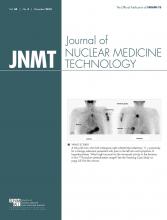Abstract
There are multiple reasons for an anterior mediastinal mass. In this case, we discuss possible etiologies and offer an algorithm to narrow the differential diagnosis. When the mass cannot be diagnosed radiographically, the next step in imaging is a physiologic assessment with radionuclide modalities.
There are multiple reasons for an anterior mediastinal mass. In this case, we discuss possible etiologies and offer an algorithm to narrow the differential diagnosis.
CASE REPORT
A 50-y-old woman presented to the Nuclear Medicine Department for evaluation of a mediastinal mass. The patient had an 8-y history of this mediastinal mass, with recent interval increase in size visualized on chest CT angiography obtained for an unrelated reason. Because of high suspicion for lymphoma, PET/CT for further workup of the enlarged mass was performed. The patient was injected with 658 MBq (17.8 mCi) of 18F-FDG. The mediastinal mass was non–18F-FDG avid (Fig. 1), and there was no abnormal 18F-FDG uptake in the thyroid region. Given the negative PET/CT result, it was recommended that the patient undergo a technetium thyroid study because ectopic thyroid tissue was of concern. The patient was injected with 351 MBq (9.5 mCi) of 99mTc.The study showed the thyroid gland in a hypertrapping state and no radiotracer activity in the substernal region (Fig. 2). Because of a continued high suspicion for ectopic thyroid tissue, the patient underwent a limited SPECT/CT with 123I of the neck and upper thorax after the oral administration of 15 MBq (424 μCi) of 123I. The images showed activity in the thyroid gland as well as in the substernal soft-tissue density located adjacent and anterior to the aortic arch (Fig. 3). These findings are consistent with substernally located ectopic thyroid tissue.
Non–18F-FDG avid anterior mediastinal mass. AC = attenuation corrected; MIP = maximum-intensity projection.
99mTc study showing thyroid gland in hypertrapping state and no radiotracer activity in substernal region.
123I with SPECT/CT of neck and upper thorax showing activity in thyroid gland as well as in substernal soft-tissue density located adjacent and anterior to aortic arch. AC = attenuation corrected; MIP = maximum-intensity projection.
DISCUSSION
The differential diagnosis of a mediastinal mass is widespread and most frequently includes the lymphoma, thymic mass, germ cell tumor, and ectopic thyroid tissue, with primary thymic neoplasms, thyroid masses, and lymphomas most commonly diagnosed in the adult population (1). The morphologic and radiologic features of each process help to differentiate and diagnose the mediastinal mass. When there is suspicion of a mediastinal mass, a posteroanterior and lateral chest radiograph is typically the first-line imaging. Although this basic modality provides limited tissue characterization, mass localization is achieved, which can aid in narrowing the differential diagnosis. CT is an important tool in evaluating a mediastinal mass and is typically the next step after chest radiography. CT imaging has the ability to further characterize the mass based on specific location; degree of soft-tissue vascularization; and attenuation of air, fat, water, and calcium. These specifications are often sufficient in achieving a diagnosis (1,2).
However, when the mass cannot be diagnosed radiographically, the next step in imaging is a physiologic assessment with radionuclide modalities. The importance of nuclear studies in determining the diagnosis of mediastinal masses is usually underestimated and is not suggested by many authors (3). In this case, we will emphasize the role of nuclear studies in determining the diagnosis of anterior mediastinal mass. 18F-FDG PET/CT is an efficacious tool with many applications, largely in the setting of malignancy. In our case, PET/CT was obtained because of suspicions that the mediastinal mass represented lymphoma. Both Hodgkin and non-Hodgkin lymphomas are 18F-FDG–avid, and in general, 18F-FDG PET is more sensitive (85%–95%) and specific (95%) than CT for detecting lymphoma (4). Because of this, it has the ability to differentiate between a lymphoma versus a more benign etiology.
Similarly, thyroid scintigraphy plays a role in evaluation of mediastinal mass when thyroid etiology is being considered. Thyroid scintigraphy is performed primarily with 99mTc, 123I, and rarely 131I. The use of 99mTc over radioiodine is typically preferred for several reasons. One example is that 99mTc has a faster acquisition time than 123I because of its significantly higher allowable administered dose (185–370 MBq [5–10 mCi] vs. 7.2–11.11 MBq [200–300 μCi]). Subsequently, 99mTc is considered more patient-friendly because of this shortened examination time and less time the patient is required to lie supine with an extended neck. Another reason that 99mTc is preferred is that it is more convenient and more readily available to hospital radiopharmacies than 123I and, as a result, is better able to accommodate last-minute scans (5).
As was the case with our patient, she underwent thyroid scintigraphy with 99mTc initially, presumably because of the numerous above-mentioned benefits of 99mTc over 123I. However, when there are suspicions that a mediastinal mass represents functioning thyroid tissue, imaging with either 123I or 131I is the method of choice, not 99mTc. This is because of the increased background activity with 99mTc caused by the activity of the salivary glands in the neck, the attenuation of γ-rays by the sternum and surrounding soft tissues, and also the substantial blood-pool activity from the heart and great vessels all interfering with the visualization of retrosternal or deep functioning thyroid tissue (4,6).
CONCLUSION
It is important to recognize the applications of 123I in thyroid scintigraphy and its appropriate clinical use. It can lead to a decrease in unnecessary imaging, overall decreased health care cost, and decreased radiation exposure to the patient.
DISCLOSURE
No potential conflict of interest relevant to this article was reported.
Acknowledgments
We thank Robert Ceruti, CNMT, for his help in revising the pictures.
Footnotes
Published online Jun. 30, 2016.
REFERENCES
- Received for publication March 31, 2016.
- Accepted for publication June 1, 2016.










